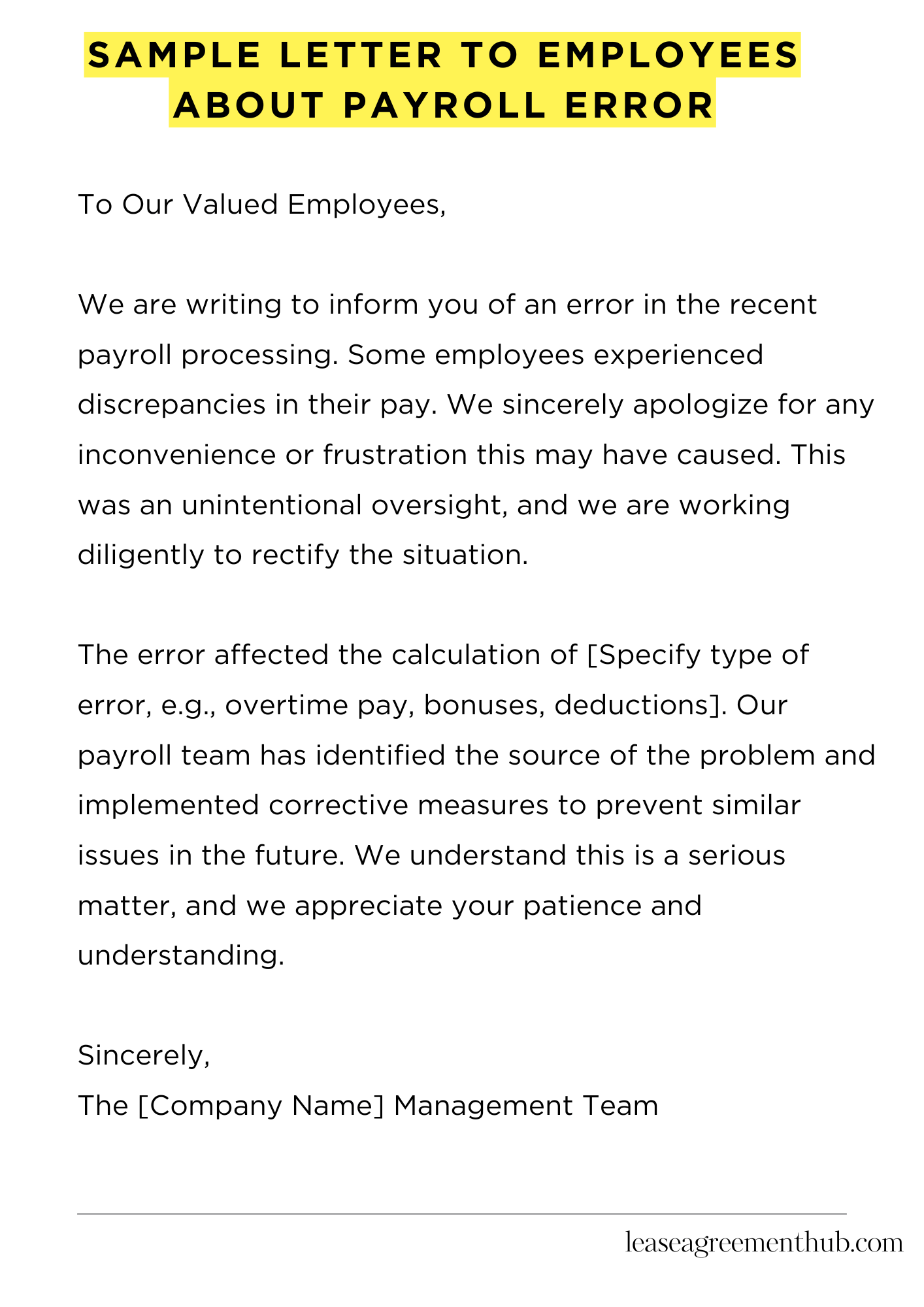Have you ever had to inform your employees about a payroll error? It can be a tricky situation to navigate, but a well-written letter can help clear up any confusion.
In this article, we will provide you with templates and examples of sample letters to employees about payroll errors. These samples will make it easy for you to communicate the issue clearly and professionally.
Whether you need to apologize for a mistake, provide clarification on a discrepancy, or offer solutions for rectifying the error, we have got you covered with our helpful sample letters.
Sample Letter to Employees About Payroll Error
To Our Valued Employees,
We are writing to inform you of an error in the recent payroll processing. Some employees experienced discrepancies in their pay. We sincerely apologize for any inconvenience or frustration this may have caused. This was an unintentional oversight, and we are working diligently to rectify the situation.
The error affected the calculation of [Specify type of error, e.g., overtime pay, bonuses, deductions]. Our payroll team has identified the source of the problem and implemented corrective measures to prevent similar issues in the future. We understand this is a serious matter, and we appreciate your patience and understanding.
We are currently processing corrected payments. You can expect to see the corrected amount reflected in your bank accounts by [Date]. A detailed breakdown of the correction will be included with your payslip. If you have already received your payment, the corrected amount will be included in your next paycheck.
If you have any questions or concerns, please do not hesitate to contact the payroll department at [Phone number] or [Email address]. We are committed to resolving this matter promptly and efficiently. Thank you for your continued hard work and dedication.
Sincerely,
The [Company Name] Management Team

How to Write a Sample Letter to Employees About Payroll Errors
Acknowledge the Issue Directly and Emphatically
Begin your communication unequivocally. Avoid obfuscation. State clearly that a payroll error has occurred. Don’t beat around the bush; transparency is paramount. This upfront honesty fosters trust, even in a situation that may cause employee consternation.
Specify the Nature of the Payroll Discrepancy
Detail the precise nature of the error. Was it an underpayment, an overpayment, or a miscalculation involving deductions? Be specific. Use precise terminology to avoid ambiguity. For example, instead of saying “a problem with your pay,” state “an incorrect deduction of state taxes” or “an underpayment of your base salary.” Avoid jargon, and remember clarity trumps sophistication.
Articulate the Cause of the Payroll Error (If Known)
If the root cause of the error is known, explain it concisely. This demonstrates proactive investigation and accountability. However, avoid placing blame. Focus on the corrective actions. If the cause remains elusive, simply state that a thorough investigation is underway. Transparency, even without immediate answers, is key to maintaining morale.
Outline the Corrective Actions Being Taken
Detail the steps being taken to rectify the situation. Will affected employees receive corrected paychecks? What is the timeline for resolution? Provide a concrete plan. This reinforces your commitment to addressing the problem and reassures your employees. Specificity, in this context, is crucial for building confidence.
Offer a Sincere Apology for the Inconvenience
Express sincere remorse for any inconvenience or distress caused by the payroll error. An unreserved apology demonstrates empathy and acknowledges the impact on your employees’ financial well-being. Sincerity is paramount; a perfunctory apology rings hollow.
Provide Contact Information for Further Inquiries
Include contact information for employees who require further clarification or assistance. This might include a dedicated HR representative or a specific email address, even a phone number. This fosters open communication and ensures employees feel supported.
Maintain a Professional and Empathetic Tone Throughout
Your letter’s overall tone should be professional yet empathetic. Avoid accusatory language; even in a situation where employee error contributed (however unlikely), frame the response constructively. Maintain a calm, reassuring tone—this will help mitigate any potential negative responses. The goal is to reassure, not to exacerbate anxieties.
FAQs about sample letter to employees about payroll error
What information should be included in a letter to employees regarding a payroll error?
A letter addressing a payroll error should clearly state the nature of the error (overpayment, underpayment, incorrect deductions, etc.), the specific employees affected, the timeframe of the error, the steps being taken to correct it, and the expected timeline for resolution. It should also include contact information for questions or concerns.
How should the tone of the letter be?
The tone should be professional, apologetic (if applicable), and informative. Avoid blaming employees and focus on the steps being taken to rectify the situation. Maintain a transparent and reassuring tone to build trust.
What if the payroll error involves sensitive information like tax implications?
If the error impacts tax withholdings or other sensitive information, the letter should clearly explain the implications and any necessary actions employees need to take. Consider providing links to relevant resources or contact information for tax professionals if needed.
Should the letter be sent to all employees or only those affected?
Generally, the letter should be sent only to the employees directly affected by the payroll error. Sending it to all employees might cause unnecessary confusion and concern. However, a company-wide announcement might be appropriate if the error is widespread or impacts a significant portion of the workforce.
What legal considerations should be kept in mind when writing the letter?
Ensure the letter is accurate and avoids any misleading statements. Consider consulting with legal counsel to ensure compliance with relevant employment laws and regulations, especially regarding data privacy and notification requirements.
Related: